Personal History
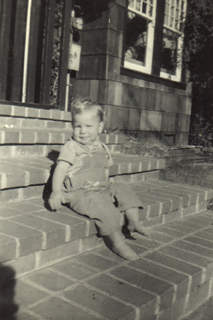 Born on October 11, 1955, I grew up on a lush, hilly neighborhood in Berkeley near the
Oakland border. The youngest of five children, and being seven years younger than my
closest sibling, a late (but not unplanned!) addition to the family, I was privileged to live
the comfortable life of a child with older, well established parents.From the 5th grade
on, when the last of my siblings went off to college, I was an only child, but with the
advantage of having a brother and three sisters.
Born on October 11, 1955, I grew up on a lush, hilly neighborhood in Berkeley near the
Oakland border. The youngest of five children, and being seven years younger than my
closest sibling, a late (but not unplanned!) addition to the family, I was privileged to live
the comfortable life of a child with older, well established parents.From the 5th grade
on, when the last of my siblings went off to college, I was an only child, but with the
advantage of having a brother and three sisters.
Music has been a big part of my life from the beginning and was a major influence in the family. My mother was a cellist, often inviting her friends over to play string quartets, my father a devoted listener to recordings of music by J. S. Bach, and both were dedicated members of the church choir. Each of the kids studied piano and my siblings all played in the school orchestra or band on such instruments as the flute, violin and clarinet. My brother also played guitar.
1960’s
One of my earliest memories is performing with the “cherub” choir in church at the age
of three. I continued singing in church and school choirs throughout my youth, and in
fact decided, after taking viola lessons in the 9th grade that I wanted to take voice
lessons starting in the 10th grade as that was where my heart was. I was fortunate to be
exposed to quality music-making throughout my childhood both at church and especially
in the Berkeley schools. In the mid-1960’s I sang alto, alongside my mother, in a
performance of Bernstein’s Chichester Psalms, then a newly-composed hit, at St.
John’s Presbyterian Church. Berkeley High School had a very strong music program—
remember, this was pre-Proposition 13—and during my sophomore and junior years I
sang in very credible performances of Beethoven’s Ninth Symphony and, believe it or
not, Britten’s War Requiem.
I continued singing in church and school choirs throughout my youth, and in
fact decided, after taking viola lessons in the 9th grade that I wanted to take voice
lessons starting in the 10th grade as that was where my heart was. I was fortunate to be
exposed to quality music-making throughout my childhood both at church and especially
in the Berkeley schools. In the mid-1960’s I sang alto, alongside my mother, in a
performance of Bernstein’s Chichester Psalms, then a newly-composed hit, at St.
John’s Presbyterian Church. Berkeley High School had a very strong music program—
remember, this was pre-Proposition 13—and during my sophomore and junior years I
sang in very credible performances of Beethoven’s Ninth Symphony and, believe it or
not, Britten’s War Requiem.
Besides the music programs at school and church I always had art projects going on at
home. From abstract painting and pastels when I was younger, I moved on the jewelry,
then macramé and finally sewing in high school.
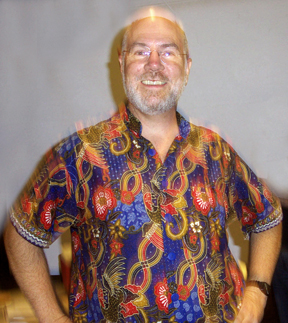 Sewing has been a passion that has
stuck with me ever since. I’ve made countless shirts, each a unique design, for myself
and loved ones, in addition to gifts and commissions of women’s garments for family
and friends as well as quilts, hats, bags and banners, etc. I even went to fashion design
school for two years, thinking that I might be able to support myself in fashion in order to
be a musician. (Wrong!)
Sewing has been a passion that has
stuck with me ever since. I’ve made countless shirts, each a unique design, for myself
and loved ones, in addition to gifts and commissions of women’s garments for family
and friends as well as quilts, hats, bags and banners, etc. I even went to fashion design
school for two years, thinking that I might be able to support myself in fashion in order to
be a musician. (Wrong!)
1970’s
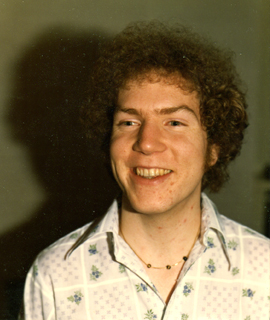 At the age of sixteen I had a vision. One day, while crossing the campus after school let
out, I was visited by a band of angels. They told me that my purpose in life was to be a
musician, and I decided right then that this would be the path I would follow. Upon
graduating for Berkeley High, in 1973, I went on the California State University at
Hayward, now called CSU East Bay, as a voice major.
At the age of sixteen I had a vision. One day, while crossing the campus after school let
out, I was visited by a band of angels. They told me that my purpose in life was to be a
musician, and I decided right then that this would be the path I would follow. Upon
graduating for Berkeley High, in 1973, I went on the California State University at
Hayward, now called CSU East Bay, as a voice major.
After two years I dropped out to
“find myself” and to get some real world experience as an adult. During that year I
began composing in earnest, something I had dabbled in during high school. I returned
to Cal-State as a 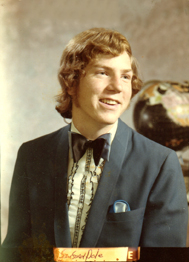 composition major but again dropped out after a year. At this point,
now 21, I had already been a member for the San Francisco Symphony Chorus for
three years, was beginning to come out as a gay man, and didn’t feel I was getting
anything out of school that would further my budding career as a musician. Although I
wasn’t yet getting paid, I was performing with a professional ensemble, the SF
Symphony, and had begun working as a church musician. In the spring of 1977 I moved
into a studio apartment in San Francisco and began the life of a starving musician in the
big city, working days in a series of retail jobs to pay the rent.
composition major but again dropped out after a year. At this point,
now 21, I had already been a member for the San Francisco Symphony Chorus for
three years, was beginning to come out as a gay man, and didn’t feel I was getting
anything out of school that would further my budding career as a musician. Although I
wasn’t yet getting paid, I was performing with a professional ensemble, the SF
Symphony, and had begun working as a church musician. In the spring of 1977 I moved
into a studio apartment in San Francisco and began the life of a starving musician in the
big city, working days in a series of retail jobs to pay the rent.
The following year a fellow tenor in the Symphony Chorus, who also sang alto in the
Grace Cathedral Choir of Men and Boys, asked me I wanted to join him and a few other
friends in an evening of singing through choral music for men’s voices. That evening led
to the first concert, and few months later in the old Mission Dolores, of Chanticleer. Of
course this group has gone on the world renown since then. I sang with them for the
first four years, which included the group’s first European tour, during which we won
second place in a prestigious international competition, the first two recordings
(Chanticleer on Tour and Psallite! which have just been re-released for the 35th
anniversary celebrations) and the first US tour; a total of 17 weeks traveling around the
country, 10 of us in a van driving 100-300 miles every day. At the conclusion of the tour I
felt I had “done” it all—the tours, the recordings, etc.—and had discovered that that life
of a touring musician is not all that glamorous. Not having the chance to do any
composing while on the road also began to weight heavily on me. So I dropped out of
Chanticleer and entered the San Francisco Conservatory of Music in the fall of 1982 as
a composition major.
That evening led
to the first concert, and few months later in the old Mission Dolores, of Chanticleer. Of
course this group has gone on the world renown since then. I sang with them for the
first four years, which included the group’s first European tour, during which we won
second place in a prestigious international competition, the first two recordings
(Chanticleer on Tour and Psallite! which have just been re-released for the 35th
anniversary celebrations) and the first US tour; a total of 17 weeks traveling around the
country, 10 of us in a van driving 100-300 miles every day. At the conclusion of the tour I
felt I had “done” it all—the tours, the recordings, etc.—and had discovered that that life
of a touring musician is not all that glamorous. Not having the chance to do any
composing while on the road also began to weight heavily on me. So I dropped out of
Chanticleer and entered the San Francisco Conservatory of Music in the fall of 1982 as
a composition major.
1980’s
I returned to my positions in the Symphony Chorus and the Grace Cathedral Choir of
Men and Boys, basically picking up my life in San Francisco where I had left off. I
graduated in 1985 with a Bachelor of Music degree, but decided not to take my
education any further at that time. I was already doing what I enjoyed, getting paid for it,
and had no desire to teach in an academic setting, for which I would need advanced
degrees. In 1987 the Symphony decided to add an Assistant Conductor position for the
Chorus and held auditions. Although my conducting experience at that point was limited
to having worked with a small church choir for a couple of years I held my own and was
awarded the job. In fact, standing in front of 200 singers and conducting them was a
real “aha” moment for me. There was a sense of “I can do this, and do it well” feeling
that resulted from that 10-minute audition.
1990’s
So my life continued in the same vein, working retail by day, singing and conducting in
choirs at night and on Sundays. In November on 1992 I was sitting in the choir stalls at
Grace Cathedral one Sunday morning, not listening to the sermon, when I realized that
after 12 years, I had had enough of the high church “smells and bells” experience. I
decided to look for a new job, this time as the director of a church choir, not just a
chorister. As fate would have it, the very next day the phone rang at 8:00 in the morning
—not a time that anyone who knows me would dream of calling! The caller was Rick
Fabian, one of the rectors at St. Gregory of Nyssa Church, then meeting at a rented
chapel in San Francisco’s Pacific Heights. He had been given my name as someone
connected to the Bay Area music scene capable of recommending qualified persons for
the position of Music Director at the church. But this was a unique situation. The church
was involved is exploring new ways of doing liturgy, creating a welcoming environment
that encouraged participation by all congregants in every aspect of the service.
Actually the word “new” is a misnomer in this context. Through his extensive research
and understanding of the early Christian church, including the 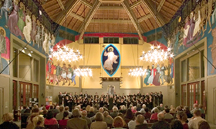 Orthodox as well as
western practices along with a keen knowledge of Asian and other religious form’s,
Rick’s idea was to return to the liturgy aspects of these earlier models that would foster
the concepts of welcome and participation. As he explained to me during that fateful
phone call, the service is sung throughout by the entire congregation in harmony, a
cappella. And during the service the congregation moves around the space via simple
line dances that are taught in the moment. There is a choir as well, which, in addition to
singing unaccompanied anthems, supports the congregational singing.
Orthodox as well as
western practices along with a keen knowledge of Asian and other religious form’s,
Rick’s idea was to return to the liturgy aspects of these earlier models that would foster
the concepts of welcome and participation. As he explained to me during that fateful
phone call, the service is sung throughout by the entire congregation in harmony, a
cappella. And during the service the congregation moves around the space via simple
line dances that are taught in the moment. There is a choir as well, which, in addition to
singing unaccompanied anthems, supports the congregational singing. 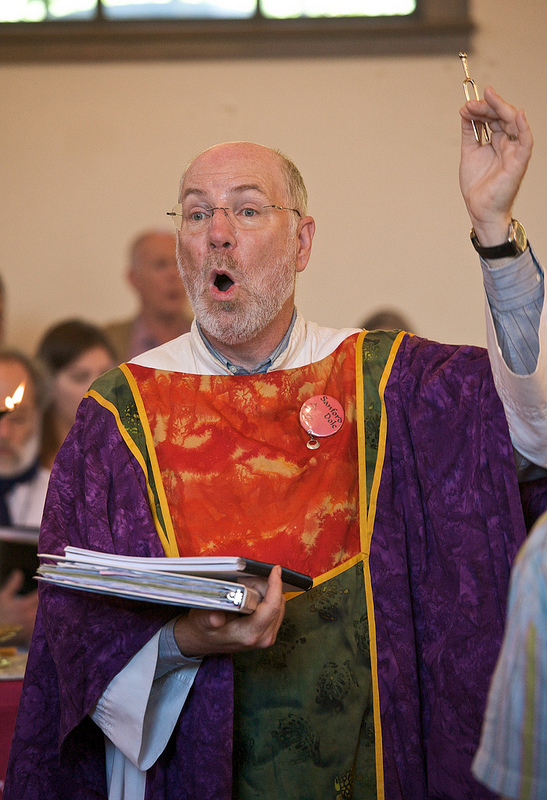
He suggested that the person they were looking for needed to be a strong singer, as he
or she would be leading the service as “cantor.” This person didn’t need keyboard skills
as there was no organ or piano. And since they were creating a new liturgical form,
being able to compose new music tailored to their needs would be helpful. Talk about
bells going off in my head!I told Rick that I had one person to suggest for the position;
myself. After an audition, in which I worked with the four members of the choir and
actually introduced one of my (rather difficult) anthems, I was awarded the job. I began
the second Sunday of 1993. It has been over 20 years now, and I’ve loved every
moment of it. I feel so blessed that I get to do this job which uses all of skills to great
advantage. Lots of photos and extensive written material about St. Gregory’s and it’s
origin, liturgy and mission can be found at: www.saintgregorys.org
Over the years since my graduation from the Conservatory in 1985, I periodically asked myself if I should pursue getting an advanced degree in music. For may years the answer remained the same; I’m doing what I want to be doing professionally so there is no reason to continue studies. This was in part due to my having formed the Sanford Dole Ensemble in 1991 as a way to gain experience conducting and to explore the choral music that interested me the most. I put together several chamber choir concerts and we were even invited to be the “house chorus” for programs of new music written by local composers’ groups. But in the mid-Nineties I began to yearn for a job as conductor of a large chorus with attendant opportunities for creative programming and conducting. I did apply for several jobs with Bay Area choruses as they came open but never made it past the first cut. This was simply because I didn’t meet the requirement of a Master’s degree or higher. Finally, one day in 1998, as I was driving near Golden Gate Park, a voice in my head said, “Now is the time,” and I found myself not going where I had planned, but instead turning toward the Conservatory to pick up an application.
The SF Conservatory only offers a degree in orchestral conducting, but strategically this was fine with me, as my goal was to one day conduct the large choral/orchestral masterpieces that I had grown to love over my years with the Symphony. I would need a good technique and a feeling of comfort in front of an orchestra, so this intensive experience working with instrumentalists would be a valuable opportunity. I took a few lessons with Denis DeCoteau, the late and beloved conductor of the SF Ballet Orchestra, to prepare for the auditions conducting the Conservatory Orchestra. From about 10 auditionees I was one of two candidates accepted for the two-year Master’s degree program.
Initially, my primary conducting teacher was Jung Ho Pak, who had been a classmate of mine in the ‘80s, and now conductor of the San Diego Symphony. He had just been hired to be the conductor of the Conservatory Orchestra and planned to commute between the two jobs. But the schedule never worked well for him and he missed many of our planned lessons. My fellow conducting student and I felt adrift. As a result, the Conservatory staff arranged with David Milnes, conductor of the UC Berkeley Orchestra to work with us as well as his students at Cal. This turned out to be a godsend as David is an excellent teacher. He gave us an exquisite grounding in conducting technique modeled on the approach he had learned from his teacher, Otto Mueller, at Yale. Working with David Milnes, as well as the courses I took while in the Master’s program, was an experience I am most grateful for, and will always remember fondly.
2000’s
Something about my internal clock seems to be well calibrated because less than a
week after I graduated from the Conservatory with a degree in hand I ran into an old
friend who was consulting with the Baroque Choral Guild, a local community choir. She
mentioned that they were in a search for a new music director. This sounded like a good
opportunity.  But before I could even act on the tip I was contacted by the organization
with word that I was on their “short list.” Would I be interested in applying? Within a
month I found myself conducting the choir at an audition and began as Music Director in
the Fall of 2000. In 2004 my title was upgraded to Artistic Director and I’ve enjoyed
watching the group grow; both musically and organizationally as we’ve made it through
structural changes that led us to become Cantabile Chorale for a few years before
finally returning to our old “BCG” moniker when we became the Bay Choral Guild in
2008. It has been a wonderful ride, helping the group to grow as an organization and
musically. It has been exciting to present my own works as well as introducing other
living composers music to our singers and audiences including several commissions
and local premieres.
But before I could even act on the tip I was contacted by the organization
with word that I was on their “short list.” Would I be interested in applying? Within a
month I found myself conducting the choir at an audition and began as Music Director in
the Fall of 2000. In 2004 my title was upgraded to Artistic Director and I’ve enjoyed
watching the group grow; both musically and organizationally as we’ve made it through
structural changes that led us to become Cantabile Chorale for a few years before
finally returning to our old “BCG” moniker when we became the Bay Choral Guild in
2008. It has been a wonderful ride, helping the group to grow as an organization and
musically. It has been exciting to present my own works as well as introducing other
living composers music to our singers and audiences including several commissions
and local premieres.
In 2007 Rick Fabian, and his co-rector, Donald Schell announced that they planned to retire from leadership at St. Gregory’s. As a result I began to ask myself if it was time to move on. Upon hearing this some very generous members of the congregation asked how they could support me so that I would stay at St. Gregory’s. I mentioned that ever since my second stint at the Conservatory I hadn’t done any concerts with Sanford Dole Ensemble (SDE). And I had a dream; I wanted to focus on contemporary music working with professional musicians. A mentor had told me to identify a niche in the local arts scene that was not being filled. Having thought about this I told my friends that, mostly due to the costs, none of the Bay Area music groups were presenting those worthy new works that were scored for both voices and instruments. If I could secure funding I knew that with my skills we could fill this void in a grand fashion.
They agreed to help me and SDE came out of hiatus as an all-professional ensemble. I discovered a delightful reworking of Handel’s Messiah, incorporating many of the musical styles that have come since Handel’s time, by the English composer, Paul Ayes. We presented the US premiere of this partially completed work in December 2008. It was so successful that we commissioned him to complete the piece and flew him here to attend the premiere the following year. Since then we have presented a variety of mostly 21st century masterworks by emerging composers to great acclaim. However, due to changing priorities my primary funders had to withdraw their support in 2011. And with the economic downturn we had found it impossible to secure foundation and corporate funding for our mission. So, as of this writing in 2013, SDE is once again on hiatus. However I have hopes that the group will surface again in some guise as I find the where-with-all to champion the cause of new music.
2010’s
Along with the excitement of presenting Sanford Dole Ensemble concerts I’ve had the
opportunity to do more composing in recent years. After a commission from the Oakland
Symphony Chorus, which resulted in “The Fabric of Peace” a 35-minute cantata, I
received another commission, this time from Pacific Mozart Ensemble. I have an idea
that maybe that piece for 8-part chorus, “Water: Making Everything New,” will become a
movement in a larger choral concerto about the elements. But I have yet to find the
appropriate texts for the other movements.
Although I’ve done quite a bit of arranging and written smaller anthems, etc., my most recent large work is a collaboration with the playwright, Brad Erickson. I was asked by the chamber group CMASH (Chamber Music Art Song Hybrid) to compose a work for two sopranos and piano. I enlisted Brad’s help on the project and he had the idea that we could mine the life story of Gertrude Stein and Alice B. Toklas. The result is “Gertrude and Alice: Scenes from a Shared Life.” While my original concept would be that this was more of a song cycle, it evolved into a chamber opera with the imaginative staging by Ann Moss and Heidi Moss at the 2012 presentation of the work-in-progress. They presented around 23 minutes across three songs. Eventually there will be two more songs to complete the set examining the extraordinary lives of this amazing couple.
Beyond that I have dreams of writing more large-scale works, including an opera about the Cisco Kid, again collaborating with Brad Erickson on the libretto, a choral/orchestral setting of John Dryden’s poem “Song for St. Cecelia,” a Requiem and much more. Along the way I’m sure there will be many smaller choral works and I would like to compose more orchestral and chamber music as well. Stay tuned!
For a list of my compositions, and to see/hear some of the scores please go the compositions page on this site.
![]()


